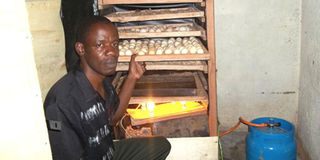Kerosene and gas incubators make hatching easy

Nerbert Jumba who makes incubators in Mumias. PHOTO | NATION MEDIA GROUP
What you need to know:
- According to Jumba, when the incubator is connected to electricity, it is controlled by a thermostat which is able to maintain the required temperature at 37 degrees Celsius.
- Jumba explains that while using the gas or kerosene powered incubator, the eggs are turned manually after every six hours.
- Candling help sto ensure one hatches only good eggs. A good egg for hatching should be free of cracks and the interior must not have blood spots.
The small white truck loaded with a wooden structure stops at a dusty trading centre known as Shianda in Mumias, Kakamega County.
Cheering on are a group of farmers belonging to Mumias Central Women’s Group, who had been waiting for the wooden incubator that they are eager to start using to change their lives.
Nerbert Jumba, a trainer and coordinator of Green Youth Foundation, an organisation that works with the youth, which was donating the incubator leads the farmers in offloading the gadgets.
He goes ahead to demonstrate to the farmers how the incubator that he powers with gas works.
“This machine uses electricity, gas or kerosene. It is ideal for farmers who do not have electricity because they can use gas or kerosene,” he says.
The farmers listen carefully as Jumba connects one of the incubators on a 6kg cylinder and the machine roars to life.
The gas powered incubator with a capacity of 1,050 eggs goes for Sh45,000.
This is lower than the machine-made ones sold in the market, which retail at an average of Sh105,000.
Jumba explains to make the incubators, they engage carpenters who construct the body.
“After constructing the body, the burning chambers for gas and kerosene are installed, together with other electrical gadgets. Each chamber costs Sh1,600,” says Jumba, adding that making an incubator costs an average of Sh22,000.
According to Jumba, when the incubator is connected to electricity, it is controlled by a thermostat which is able to maintain the required temperature at 37 degrees Celsius.
Likewise, when the incubator is connected to gas or kerosene, it is controlled by a regulator that maintains the temperature.
Six kilos of gas last 45 days. This implies it can hatch two sets of eggs, with each session lasting 21 days. A 6kg cooking gas cylinder in Mumias Town goes for Sh1,100.
The gadget, according to Jumba, consumes power worth Sh750 in 21 days and eight litres of kerosene during the same period.
To use kerosene, one pours the fuel into the chamber to soak the wick and then lights; adjusting the flame to ensure there is no smoke.
Then wait for the temperature inside to rise to around 37 degrees Celsius and once it stabilises, load eggs with the broad end facing up for air circulation.
Once it begins working, the incubator must be checked repeatedly during its operation to regulate the temperature, humidity and adjust the flame as necessary.
If too warm, one should reduce the flame light and place water inside when humidity is too low and vice versa, keeping the wick in check too, just to ensure it gives quality flame.
Juma Omar, a member of the Mumias Central Women’s Group, is among the beneficiaries of the incubator.
The farmer has 50 chicks hatched from the incubator that he is rearing having bought them from the foundation for Sh2,000.
Jumba explains that while using the gas or kerosene powered incubator, the eggs are turned manually after every six hours.
However, for the first three days and the last three days, the eggs should not be turned. This is because during the first three days, the embryo will be developing and any turning may destroy it. While in the last three days, the chick will be fully developed.
“The fertility of all the eggs is checked using a candler to ascertain if they will hatch before they are put in the incubator. We have trained the farmers how to use the gadgets,” says Jumba, who holds a Bachelor of Education degree in Mathematics and Chemistry and has learned how to make incubators.
Candling help sto ensure one hatches only good eggs. A good egg for hatching should be free of cracks and the interior must not have blood spots.
Using a candler, a farmer will also know which eggs are fertile, which will hatch into chicks or tell if a fertilised egg has stopped developing.
“These incubators are not only good for places where there is no electricity but they also come in handy when there is a power blackout. When power goes off, you connect the gadget to a gas cylinder and the process continues without interference,” says Jumba, adding that they are also training selected farmers on how to make the gadget.
Livestock expert Felix Opinya from Egerton University says the kerosene incubator works as good as the one powered by electricity or gas, although it needs close attention.
“Kerosene powered incubators are available in different egg capacities and they are easily made at home with locally available materials. They give high success rate when handled well.”





